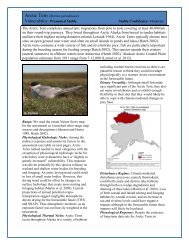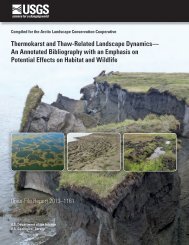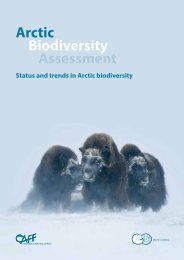Assessing Climate Change Vulnerability of Breeding Birds in Arctic ...
Assessing Climate Change Vulnerability of Breeding Birds in Arctic ...
Assessing Climate Change Vulnerability of Breeding Birds in Arctic ...
Create successful ePaper yourself
Turn your PDF publications into a flip-book with our unique Google optimized e-Paper software.
Section 1. IntroductionOf all places on the earth, climate change isoccurr<strong>in</strong>g most dramatically at the poles(Gillett et al. 2008). In the <strong>Arctic</strong>, airtemperature has <strong>in</strong>creased at almost twicethe global average rate <strong>in</strong> the past 100 years,accompanied by significantly alteredweather patterns, <strong>in</strong>creased glacial and polarpack ice melt, and sea level rise (IPCC2007). More specifically, <strong>in</strong> <strong>Arctic</strong> Alaskamean annual temperature is ris<strong>in</strong>g at a rate<strong>of</strong> 0.45 °C per decade (Data from M.Shulski reported <strong>in</strong> Mart<strong>in</strong> et al. 2009;Figure 1.1). Over the next 60 years, meanannual temperatures are expected to <strong>in</strong>creaseapproximately 5 °C (Figure 1.2) and to 7 °Cby the end <strong>of</strong> the century with most <strong>of</strong> thewarm<strong>in</strong>g occurr<strong>in</strong>g <strong>in</strong> w<strong>in</strong>ter (Mart<strong>in</strong> et al.2009). Annual precipitation is expected to<strong>in</strong>crease 20-40% over the next 60 years(Figure 1.3) although <strong>in</strong>creas<strong>in</strong>gtemperatures may lessen the effects <strong>of</strong><strong>in</strong>creased precipitation by driv<strong>in</strong>g an<strong>in</strong>crease <strong>in</strong> evapotranspiration rates (TWSSNAP http://www.snap.uaf.edu/data.php).While <strong>in</strong> some <strong>Arctic</strong> sites there is evidence<strong>of</strong> tundra dry<strong>in</strong>g, the pattern is spatiallyheterogeneous (e.g., Riordan et al. 2006). Itis uncerta<strong>in</strong> whether the future will br<strong>in</strong>g anet annual dry<strong>in</strong>g or moisten<strong>in</strong>g. Moreover,it is unclear how surface hydrology andgeomorphology changes will eitherexacerbate or compensate for shifts <strong>in</strong>atmospheric moisture (Mart<strong>in</strong> et al. 2009).Regionally, recent temperature and moisturechanges are lead<strong>in</strong>g to warm<strong>in</strong>g permafrost(Romanovsky et al. 2007), <strong>in</strong>creased coastalerosion (Jones et al. 2009), more frequentfires (Rac<strong>in</strong>e and Jandt 2008), and shrub<strong>in</strong>vasion (Tape et al. 2006), likely alter<strong>in</strong>ggeomorphology, hydrology, and habitatstructure (see Mart<strong>in</strong> et al. 2009 for athorough review).Key resources <strong>of</strong> concern <strong>in</strong> the <strong>Arctic</strong>are the vast productive wetlands <strong>in</strong> northernAlaska (particularly <strong>in</strong> the <strong>Arctic</strong> CoastalPla<strong>in</strong>) and the birds that migrate from allover the globe dur<strong>in</strong>g the brief summerseason to breed. Avian research <strong>in</strong> the regionpo<strong>in</strong>ts to the unique importance <strong>of</strong> largeparts <strong>of</strong> <strong>Arctic</strong> Alaska <strong>in</strong> harbor<strong>in</strong>g some <strong>of</strong>the most important avian breed<strong>in</strong>g grounds<strong>in</strong> the entire circumpolar <strong>Arctic</strong> (Andres etFigure 1.1. 50-year trend <strong>in</strong> mean annual temperature at seven sites on the North Slope (Source: M.Shulski <strong>in</strong> Mart<strong>in</strong> et al. 2009).3








